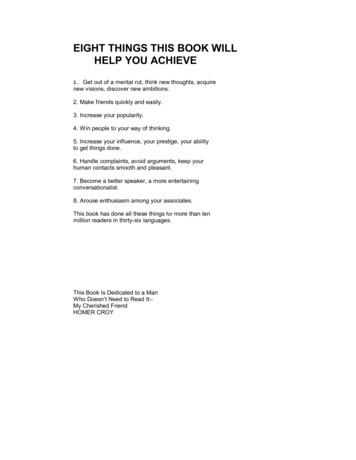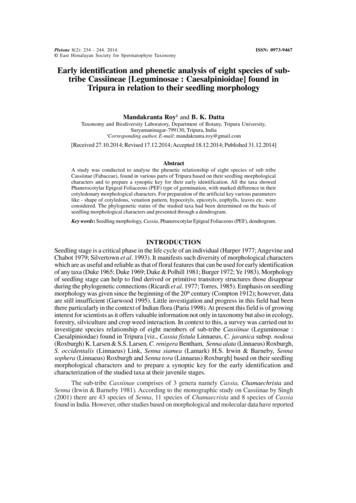
Transcription
FE967Eight Steps to Developing A Simple Marketing Plan1Edward A. Evans and Fredy H. Ballen2IntroductionMarketing is an essential component of a business (Guidry2013). In fact, it is the heart of any business, serving thevital function of transforming production activities intofinancial performance, thus ensuring the survival of thebusiness. Marketing is key regardless of the type of business(this includes agriculture). Despite the important role ofmarketing, many smallholding operators/growers are reluctant to create a marketing plan. These operators continue tooperate on the basis of trying to sell what they can producerather than producing what they can sell. Some claim theydo not have time to develop a marketing plan, while othersclaim there is no need for such a plan. The result of suchshortsightedness is that some operators eke out a meagerliving, witnessing their profit margins evaporate as theycontinue being price takers instead of price makers. Asthe saying goes, “if you fail to plan, then you plan to fail.”Whether you are a large-farm or small-farm business, youcan benefit from developing a marketing plan. Contrary topopular belief, preparing such a plan does not require anenormous amount of time and resources, but it does resultin benefits that greatly exceed the costs.In this article, we show how smallholders can develop asimple marketing plan using our eight-step guide and ourmarketing plan worksheet (Table 1). First, we explain whya marketing plan is important for your business and definewhat a marketing plan is. Second, we list eight steps to follow to develop a simple marketing plan. Third, we provide amarketing plan worksheet for your individual use.Credits: Thinkstock.comRationale for Marketing PlanA quick online search will provide a list of reasons why amarketing plan is essential for your business operation. Amarketing plan Helps you reach your target audience Helps you boost your customer base Increases your bottom line Assists you with obtaining finances Helps you set clear, realistic, measurable objectives Helps you focus your total marketing efforts1. This document is FE967, one of a series of the Food and Resource Economics Department, UF/IFAS Extension. Original publication date April 2015.Reviewed September 2018. Visit the EDIS website at https://edis.ifas.ufl.edu for the currently supported version of this publication.2. Edward A. Evans, associate professor, and Fredy H. Ballen, economic analyst, UF/IFAS Tropical Research and Education Center, Homestead, FL 33031.The Institute of Food and Agricultural Sciences (IFAS) is an Equal Opportunity Institution authorized to provide research, educational information and other services only toindividuals and institutions that function with non-discrimination with respect to race, creed, color, religion, age, disability, sex, sexual orientation, marital status, nationalorigin, political opinions or affiliations. For more information on obtaining other UF/IFAS Extension publications, contact your county’s UF/IFAS Extension office.U.S. Department of Agriculture, UF/IFAS Extension Service, University of Florida, IFAS, Florida A & M University Cooperative Extension Program, and Boards of CountyCommissioners Cooperating. Nick T. Place, dean for UF/IFAS Extension.
Definitions of a Marketing PlanPreparation of a Marketing PlanMarketing has different definitions depending on theperson you ask. Many people define marketing as sellingand advertising; however, marketing is much more thanjust selling and advertising. Concentrating only on selling(closing the deal) will not ensure that you develop a longterm customer base. Marketing is about discovering andsatisfying your customers’ needs and wants while earning aprofit. This involves attracting and retaining customers. Youattract customers by promising and delivering better valuethan your competitors. You retain customers by continuingto deliver satisfaction. Marketing is creating value for yourcustomers while extracting value from them (McDonaldand Wilson 2011).As we say in economics, “there is no such thing as a freelunch.” The good news is that preparing a marketing planis not as difficult as it sounds. It does require a minimumamount of market research, which involves collecting,analyzing, and organizing information so you can planyour actions. Market research entails obtaining informationfrom whatever sources are available to help you answer thefollowing questions:How do you create value for and extract value fromcustomers? Without getting too theoretical, it involvescreating the best mix of what is known as the 4Ps so thatthe customer realizes the highest level of benefits per unit ofcost (Value Benefits/Cost). The 4Ps include What is the best way to get your product/service into thehands of targeted consumers?1. Product/service (having something to offer that yourcustomers or potential customers need)2. Price (charging a price that is in line with the valuecustomers place on your offering)3. Promotion (letting customers know what you have tooffer and what is special about it)4. Place/distribution (getting your product/service tocustomers at a time and in a form that is most beneficialto the customers)A marketing plan is a set of orderly actions aimed at achieving specific objective(s) within a given timeframe. First,you first must have a set of objectives when creating a plan.Second, you should specify a timeframe (usually a calendaryear) within which to achieve your set of objectives.Therefore, a marketing plan is a strategic document outlining the actions/steps you propose to take to achieve yourmarketing objectives. A marketing plan helps you focusyour efforts on maximizing profits for your business. Ithelps you to clearly define the product and/or service youare offering, to identify your customers and competitors,to outline a strategy for attracting and retaining customers,and to anticipate changes in the marketplace. While theactual document is of tremendous importance, the processof preparing that document is invaluable. Developing amarketing plan will help you spend your time, energy, andresources as efficiently as possible.Eight Steps to Developing A Simple Marketing Plan What is your product/service? What market(s) do you serve? What unique (special) features distinguish your product/service from the others? Who are your customers? How should you price your product/service? How should you promote (advertise) your product/service? How is the targeted market changing or is likely tochange?Such information can be obtained in a variety of waysbesides hiring paid consultants. You can search for information online, use social media to network, communicatewith others in the industry, visit similar businesses, attendtrade shows and conferences, and/or join professionalorganizations. Once you have gathered sufficient information to answer the above questions, you can then followour eight-step guide below and use our marketing planworksheet (Table 1), to be on your way to developinga successful marketing plan. Over time, you can refineand elaborate on aspects of the marketing plan as moreresources become available and your business expands. Itis important to remember that your marketing plan is notstatic. It is a living document that needs to be routinelychecked for relevance and revised accordingly. It alsoprovides you the basis to assess each new opportunity to seeif it is in accordance with your overall goals and objectivesand to make adjustments as needed.Steps for Creating a SimpleMarketing PlanBelow are the eight steps to follow in developing a simplemarketing plan. Follow these steps and fill out the marketing plan worksheet (Table 1) to get you started.2
Step 1: State your marketing objectivesPerhaps you would like to increase awareness of the product or service you provide, increase sales and revenues by acertain percentage, and/or increase the number of customers who purchase your product or service. For example,your objective(s) could be to increase sales by 10 percent bythe end of next year, sell 50 more boxes of your product, sell10 percent of what you produce directly to consumers, orparticipate in at least one trade show. TIP: Be realistic about your marketing objectives;make sure they are specific and quantifiable so you canmeasure your progress toward achieving them TIP: Your marketing objectives can be expressed interms such as sales dollars, sales units, market share,distribution levels/channel, and awareness TIP: Try to limit the number of marketing objectives toless than four; two is ideal for most companiesStep 2: Identify demographics of yourtarget marketOne way to determine your customer demographics (e.g.,age, sex, profession, income level, education level, residency, individual or business, etc.) is to write a descriptionof your target audiences. Once you have done so, focus ononly those customers who are most likely to purchase yourproduct or service. As your business and resources grow,you can focus on a wider segment of the overall market.weaknesses? What do the customers think about yourcompetitors’ product/service? Can you capitalize on someof your competitors’ weaknesses? How can you create bettervalue for your customers? What pricing strategies are yourcompetitors using? Can you improve on their strategies? TIP: Select a set of competitors and identify theirstrengths and weaknesses. How do they promotetheir product? What is their pricing strategy? Is thereanything unique or special about their products?Step 4: Describe your product/serviceA product may be a commodity or service, or both. Whatproducts/services are you offering? How is what you offerdifferent from your competitors’ product or service? Howdo customers perceive the benefits of the product/serviceyou are providing? What do customers perceive as thespecial features of your product/service?Other questions to keep in mind when defining yourproduct/service include the following: Can you appeal toenvironmentally conscious or health-conscious customers?How are you going to present your product/service tocustomers? Is there an increase or decrease in the supply ofyour product/service on the market? TIP: Remember that without customers your businessis out of business; it is important that you give yourcustomers a reason to buy your product and to remainloyal (long-term, repeat customers) TIP: The target market is a group of customers (peopleor firms/packinghouses) for whom your marketing effort is intended; your target choice will determine yourproduction and marketing practices, not vice versa TIP: Always aim to produce what you can sell ratherthan sell what you can produce TIP: A target market is not simply whoever is buying,or will buy, your products; rather it consists of theindividuals or businesses you identify as your mostdesirable customersWhen we talk about place, we are thinking about more thanjust the physical location of a business; place also includeshow you plan to get the product/service into the hands ofyour customers (the place they need it). To do this, youneed to answer the following questions: How widely do youplan to geographically distribute your product/service (e.g.,locally, in-state, multi-state, nationally, internationally)?Are you going to be selling directly (direct marketing) tocustomers? (Direct marketing includes community supported agriculture (CSA), home delivery, farmers’ markets,mail order and internet sales, pick your own (U-pick), androadside stands.) Are you going to be selling indirectly(intermediary marketing) to packing houses or retailers?Step 3: Identify your competitionThere are several ways to go about identifying the competition. One way is to identify other farm businesses thatare offering somewhat similar products or services to thecustomers you are targeting and within your price range.Once you have identified your competitors, analyze two tofour such businesses by answering the following questions.How are these businesses doing in terms of sales anddemand for their product/service? What are the similaritiesand dissimilarities between your product/service andtheirs? What are some of your competitors’ strengths andEight Steps to Developing A Simple Marketing PlanStep 5: Define place (distribution strategy) TIP: Consider your product distribution plan anddetermine the best type of packaging3
TIP: Packaging serves to protect and preserve yourproduct and to advertise and differentiate your productStep 6: Choose your promotion strategyPromotion refers to the entire set of activities that informpeople about your product/service. Promotion inducescustomers to prefer your product/service over those of yourcompetitors. Promotion is simply how you get people toknow about the product/service you provide. It deals withhow and what you want to communicate to customers/buyers. Several tools can be used, including mass media(radio, television, internet, newspapers, magazines, yellowpages, billboards, etc.), direct mail, personal contacts,trade associations, and social media (Facebook, Twitter,Pinterest).You also need to identify the amount of resources (humanand capital) you can set aside for your promotions. TIP: Social media is one of the most cost-effectivemeans of promoting your businessStep 7: Develop a pricing strategyThere are several pricing strategies such as cost-orientedpricing, flexible pricing, and relative pricing. Cost-orientedpricing strategy involves setting your price at a certainpercentage level, say 25%, above your production cost. Flexible pricing strategy is where you vary the price dependingon the buyer or time (e.g., time of year). Relative pricingstrategy is simply using the prevailing market price to setyour own price whether it is above, below, or at the sameprice. No matter which pricing strategy you use, you needto be aware of the following: What are the pricing strategiesused by your competitors? What is your cost of production? TIP: Estimate how much it will cost for any marketingstrategy you propose in your marketing plan and stickto your budget (e.g., if you plan to participate in atrade show, estimate the costs for traveling, marketingmaterials, and booth rental)Summary and ConcludingRemarksComponents of a marketing plan may vary, but mostshould contain the following components:1. Executive Summary2. Your Goals/Objectives3. Your Business4. Your Customers5. Your Competitors6. Your Product or Service7. Your Distribution Strategy8. Your Promotion Strategy9. Your Pricing Strategy10. Your Marketing BudgetTypically, your price should be based on the prevailingmarket prices and your costs. It should cover your fullcost of production and include a profit. You can do simplemarket research to learn about what prices customerswould be willing to pay and what prices your competitorsare charging.To market your product or service effectively, you mustidentify your customers, know their needs and wants, andsatisfy those needs and wants. Developing a simple marketing plan is not as time consuming and expensive as youmay believe. While a marketing plan is not the sole factorin ensuring success for your business, it will greatly increasethe likelihood that your business remains relevant and hasthe greatest chance of succeeding. Using our eight-stepguide and marketing plan worksheet provides an easy wayto get started. TIP: To get the maximum price, try to schedule production when there is limited competing supplyReferencesStep 8: Create a marketing budgetSince you do not have unlimited resources, it is best toidentify how much time and money you want to allocate tomarketing.Eight Steps to Developing A Simple Marketing PlanGuidry, K. 2013. Marketing risk: Current issues for riskmanagement. Southern Extension Risk ManagementEducation Website. University of Arkansas, Little Rock, d M, and H. Wilson. 2011. Marketing Plans: Howto Prepare Them, How to Use Them. West Sussex, UK: Wileyand Sons.4
Table 1. Marketing plan worksheetMARKETING PLAN WORKSHEETWhat are your marketing objectives?1.2.3.What market do you serve? Who are your customers?1.2.3.Who are your competitors? What features distinguish your product/service from theirs?1.2.3.What is your product/service?1.2.3.What is the best way to get your product/service into the hands of targeted consumers?1.2.3.How do you plan to promote (make people aware of) your business, product/service?1.2.3.How do you plan to price your product/service?1.2.3.How much money and time can you set aside for your marketing activity?1.2.3.Notes:Eight Steps to Developing A Simple Marketing Plan5
Eight Steps to Developing A Simple Marketing Plan 2 Definitions of a Marketing Plan Marketing has different definitions depending on the person you ask. Many people define marketing as selling and advertising; however, marketing is much more than just selling and advertising. Concentrating only on sellingFile Size: 937KBPage Count: 5Explore furtherMarketing Plan Template - SBAwww.sba.govC 1 APPENDIX C Sample Marketing Plancollege.cengage.comDeveloping a Marketing Plan - FDICwww.fdic.govSample Marketing Plan - SBAwww.sba.govSample Marketing Plan - RRCCwww.rrcc.eduRecommended to you b











